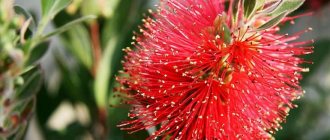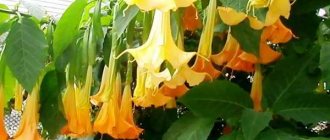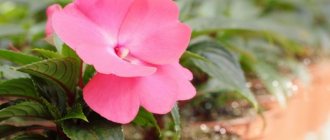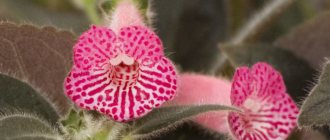Flowering occurs from late winter to early spring. The flowers are characterized by small dimensions and a white tint. They gather in small inflorescences. The leaves of the callisia plant, depending on the variety, are distinguished by the large thickness of the plate and the characteristic tone of the reverse side: it can be purple, silver, reddish or burgundy.
| Average growth rate, 7-10 cm per year. |
| Flowering occurs from late winter to early spring. |
| The plant is easy to grow. |
| Perennial. |
Types and varieties of callisia
Or graceful callisia
- a miniature plant with articulated creeping stems more than half a meter long, which first grow straight and then droop. This plant is very similar to Tradescantia. It reaches a height of 30-40 cm. Both the leaves and stems of callisia graceata are covered with velvety pubescence. The oval, pointed at the ends, petiolate, up to 6 cm long leaf plates of the plant are painted violet-green on the underside, and dark green with silver stripes on the top. This species blooms with white flowers formed at the ends of the shoots. The plant does not live very long: after two years, the leaves, which lose their bright colors, no longer cover the shoot so tightly, so flower growers restore the vine by cuttings or layering.
In the photo: Elegant callisia (Callisia elegans)
A changeable plant, the decorativeness of which depends on the variety and conditions of maintenance. This is a succulent with creeping stems that quickly take root at the nodes and succulent, lanceolate, strongly concave double-row leaves with a longitudinal hollow, painted on the upper side in a bronze-green color that shimmers red in the sun, and on the lower side - brownish-violet. The leaves are bare, but along a line ascending from the axil, covered with a fringe of small hairs, reaching a length of 2 and a width of 1.5 cm.
In the photo: Callisia navicularis
A plant up to 20 cm high and up to 30 cm wide with thin reddish or purple stems and small heart-shaped bright green leaves with purple specks located on them in two rows. The flowers of this species are white and inconspicuous. At home, callisia repens is grown in hanging structures, and in the garden it is used as a ground cover plant. The following garden forms are known:
- Bianca
is a callisia with red-violet tender stems and small bright green leaves; - Pink Panther
is a variety with striped pink-green leaves.
Also popular are varieties of creeping callisia Pink Lady, Noum Popula and Tortle.
In the photo: Creeping callisia (Callisia repens)
Or Thai callisia,
or golden mustache can also be found under the names “Far Eastern mustache”, “living hair”, “domestic ginseng” and “corn”. This is a larger plant than, for example, small-leaved creeping callisia grown at home. The height of fragrant callisia can reach one and a half meters, but it definitely needs support, otherwise the vine may break under its own weight. Callisia fragrans has two types of stems: short, fleshy and vertical, ending in a large rosette of leaves, and long, tubular horizontal shoots, jointed tendrils, which serve the plant to capture new area. The leaves of this species are fragrant, large, leathery, dark green, up to 30 cm long and up to 6 cm wide. They are glossy on the upper side, matte below, and when grown in bright light the leaves turn pink.
In the photo: Callisia fragrans
Callisia
(Callisia) is a perennial herbaceous plant that can be erect or creeping. Very popular among lovers of indoor flowers.
Some types
are not only decorative, but also medicinal.
These include fragrant callisia (the well-known Golden Mustache
). At home, the creeping and elegant Callisia is most often grown.
Diseases and pests
Callisia when grown at home is subject to the following problems:
- Callisia stems stretch out - the plant does not have enough light.
- Callisia grows slowly - there is a lack of fertilizing.
- Small and pale young leaves - lack of mineral fertilizers.
- Callisia leaves are soft - the ambient temperature is too low.
- The bases of the leaves rot - liquid gets into the center of the rosette when watering.
- Brown spots on callisia leaves mean the air in the room is too dry.
- The plant grows quickly - it is considered a natural process; to prevent it, rejuvenation by cuttings is used.
Among other common problems, plant growers note root and stem rot. Diseases appear due to the moisture of the earthen clod and improperly organized drainage. Pests that attack callisia: spider mites, thrips and scale insects.
Caring for callisia at home
Since the natural habitat of callisia is tropical rainforests, the green beauty simply adores water and, therefore, needs it immensely. Thus, the plant is watered intensively. But this only applies to periods of active growth. In the fall, soil moisture under the flower is limited, and in winter it is reduced even more. However, make sure that the earthen lump does not dry out. In the same way, flooding of soil is not allowed. For water procedures, use only soft moisture at room temperature.
Starting from March and until the end of the summer season, callisia is fed. A complex mineral concentrate is used as a fertilizer for this purpose. Feeding is done frequently, once a week.
Every spring the plant needs to be replanted while it is young. For a mature plant, changing the substrate and pot is more rare - once every two years. The soil is used of the same composition as at the time of planting the exotic. Be sure to ensure that the soil has a slightly acidic reaction. At the bottom of the pot, arrange a high-quality layer of drainage material.
The rejuvenation procedure is also applicable to callisia. It involves re-rooting the apical shoots of the plant. This event is relevant due to the rapid so-called growth.
New callisia specimens are obtained by propagating the plant by cuttings. This is the simplest and most common method among gardeners. If you use apical shoots as propagation material, root them in an aquatic environment. If your choice fell on a horizontal cutting crowning a horizontal layer, carefully cut the shoot under the rosette and plant it in nutritious soil, attaching the shoot to the ground using a special wooden hook. The seedling should be sprinkled with soil on top
As soon as the shoot takes root, it must be carefully separated from the main exotic and planted in another container, in a permanent place
How to care for callisia at home
The flower itself is not very picky, but there are still certain conditions that must be met for proper cultivation.
Selecting a location
Choosing a location is a fairly important step when planting a plant. For callisia, it is necessary that the area is well lit, but it is better not to be exposed to direct sunlight. This could be a window sill if the windows are not on the sunny side, deep in the room, a table, a shelf perpendicular to the window, etc.
It is important that there is good air circulation in the room
There is no need to select special soil, for example, you can take a substrate for succulents or any other
However, it is important that the soil is light. You need to water regularly and increase the amount of water during the spring-summer period, when the air temperature is very high.
For your information! Fertilizing with mineral fertilizers by mixing it into the water for spraying will also be beneficial. The procedure must be carried out from May to September.
If the plant has grown too much and there is no longer enough space in the pot, it needs to be replanted. This can be done in two ways: transplant into a larger container or divide the plant into two parts.
Do not forget about cleaning yellowed or dry leaves, as well as damaged stems.
Transplanted Callisia repens
Air temperature
For callisia, the best temperature is 20-25°C, so in summer it has no problems. In winter, it may be difficult to maintain the temperature, but if it is not lower than 16°C, then everything will be fine. Of course, the flower will slow down its growth, but it will not disappear.
Important! The air temperature may fluctuate, but if this happens sharply, the plant will soon die
Air humidity
Water requirements largely depend on the origin of the plant. Since callisia comes from the subtropical and tropical regions of the USA, it requires high air humidity. In order for this plant to develop properly, bloom and smell, it is necessary to spray it regularly (preferably every day) and not allow streams of hot air to blow on it, that is, it is not recommended to place pots next to a radiator, heater, stove, etc.
Golden mustache medicinal and beneficial properties
It is believed that fragrant callisia, or, as it is also called, golden mustache, has medicinal properties. Research on this topic is still being carried out. Some of the medicinal properties have been confirmed, but the plant should not be considered a panacea for absolutely all diseases.
It is necessary to take drugs based on it with caution and it is recommended to consult a doctor before use.
In the 80s, a group of scientists from the Irkutsk Medical Institute, Faculty of Pharmacy, under the leadership of Professor Semenov, conducted a study on whether this golden mustache can really be used to treat certain diseases. This study confirmed the medicinal properties of the plant.
Chemical composition
Callisia fragrant juice contains two flavonoids - quercetin and kaempferol, as well as the active substance beta-sitosterol. The composition also contains iron, copper, chromium.
Benefits and harms
It is believed that the medicinal properties of the golden mustache help fight diseases such as:
- atherosclerosis;
- metabolic disease;
- diseases of the endocrine system;
- various types of colds, etc.
The golden mustache is also actively used in cosmetology.
Professor Semenov's research showed that the effectiveness of the golden mustache appears only in the first week. During this week of taking the drug, phytosteroids gradually accumulate in the body. This leads to their overdose and, in most cases, the opposite effect occurs.
Long-term use of golden mustache tinctures can damage the vocal cords, which will be difficult to restore later.
Contraindications and side effects
When taking medications based on golden mustache, you must refrain from consuming carbonated drinks, baked goods, dairy products and animal fats. Be sure to follow the dosage and instructions of the drug. Under no circumstances should you drink undiluted plant juice. Allergic reactions are possible.
Absolute contraindications for use:
- pregnancy and lactation period,
- children under 12 years of age,
- kidney failure and other kidney problems,
- BPH,
- individual intolerance.
Infusion
Infusions of golden mustache are used to treat boils, pancreatitis, liver diseases, and colds.
Decoction
Decoctions based on callisia are used to alleviate menopause.
Ointment
Ointments are used to treat joint diseases and as a cosmetic product.
2.Caring for callisia
The flowers are usually inconspicuous and appear in the summer.
2.2.Diseases and pests
The tips of the leaves turn brown and dry out when there is insufficient air humidity. Rotting due to waterlogging and stagnation of water, especially in the autumn and winter. When grown in low light conditions, plants become loose and elongated, and the leaves become smaller.
The most common pests are aphids, thrips, scale insects, mealybugs, whiteflies and red spider mites.
Insects - pests
| Insect name | Signs of infection | Control measures |
| Whitefly | Small light spots on leaf blades, yellowing and falling leaves. Disturbed white, small butterflies fly up from the surface of the leaves | Chemicals: Zeta, Rovikurt, INTA-VIR, Fufanol and even Karbofos, Aktellik, Aktara, Confidor, Commander, Tanrek. Folk remedies: soap solution, garlic solution, yarrow and tobacco infusion, dandelion infusion, sticky traps for adult insects |
| Mealybug or feltworm | The surface of the leaves and shoots is covered with a fluffy, cotton-like white coating. Plants lag behind in development | Folk remedies: spraying with soap and alcohol solution. Infusions of tobacco, garlic, cyclamen tubers, alcohol treatments, and pharmacy tincture of calendula have worked well. Chemicals: green soap solution, Actellik, Fitoverm. |
| Spider mite | Inconspicuous cobwebs on the leaves, yellowing and falling leaves with extensive damage. The surface of the leaf plates becomes dead and covered with small cracks. Plant development slows down. | Folk methods. Plants can be washed in the shower and left in the bathroom in a humid atmosphere for half an hour. Irradiation with an ultraviolet lamp every week for 2 minutes. Chemical preparations based on pyrethrum, sulfur powders, Fitoverm, Actellik. |
| Aphid | Sticky droplets appear on the leaf blades, the leaf blades curl and become deformed, tender buds and young leaves wither. Colonies of insects can be seen on the tips of shoots, buds or the underside of leaf blades. The flowers of plants affected by aphids may become deformed. | Folk methods: nettle infusion, decoction of rhubarb leaves, wormwood, soap solution, infusion of tobacco and dandelion, onion, marigold, yarrow, tansy, dusting with wood ash. Chemicals: Sulfur powders, treatment of green mass with green potassium soap without getting into the ground, Decis, Actellik, Fitoverm. |
| Trips | The appearance of yellow spots on the leaf blades; small brown dots can be observed on the underside of the leaves. When pests spread, they cause leaves to turn yellow, dry out and fall off. | Folk methods. Increase air humidity, wipe the surface of the leaves with a soap solution to reduce the number of pests. Preparations based on pyrethrum - 2-fold treatment with an interval of 7 - 10 days, spraying with tobacco infusion, infusion of yarrow or Persian chamomile, decoction of cyclamen tubers. Chemical preparations: dusting with sulfur powders, using anabasine sulfate in a soap solution. |
| Scale insect and false scale insect | Sticky droplets on the leaves, small yellow spots on the surface of the leaf blades. When scale insects become widespread, they cause leaves to dry out and fall off. Flowers slow down their development | Folk methods of struggle. Spraying with soap and alcohol solution. Scale insect larvae do not like garlic infusion; they also use pyrethrum-based products. Chemicals. Fitoverm, Aktellik, Fufanon. |
- Whitefly
- Mealybug
- Spider mite
- Aphid
- Trips
- Shchitovka
2.3.Growing at home
Regularly pinch out the tips of young shoots to maintain the plant's compact shape. If pruning is not carried out, the plant will look untidy. Promptly remove leaves that are too green, which also spoil the appearance of the plant. Place callisia outdoors during the summer months, sheltered from strong winds and rain.
2.4. Reproduction of callisia
Callisia is a close relative of Tradescantia and is also propagated by cuttings taken in the spring. Cut cuttings 5 - 10 cm long and remove the lower leaves from them. Root in a damp mixture of peat and sand or in a simple glass of water. For rooting, you can use powdered growth hormones. Cover young plants with a clear plastic cover or glass to maintain humidity and place in a warm location in partial shade. Rooting takes 2 - 3 weeks.
Possible problems
Callisia is susceptible to rot. The disease develops due to too frequent watering or lack of drainage. The problem is eliminated by removing the affected parts and further processing the cuts with charcoal. For better effect, change the soil to a new one. In case of significant damage, additional treatment with fungicides (Oxychom, Bayleton) is performed.
Problems often arise due to violations of care rules. To understand what mistakes were made, evaluate the symptoms:
- Drying of the ground part - too infrequent watering.
- Brown spots on leaf blades indicate low air humidity in the room.
- Slow growth, small size and pallor of young foliage - lack of nutrients in the soil.
- Excessive softness of the sheet plates means the air temperature is too low.
- Rotting of the bases of the leaves - when watering, water gets to the center of the rosette.
Attention!
If callisia leaves turn yellow and fall off, this indicates that the plant is suffering from too much light or waterlogging.
Thrips and spider mites are dangerous pests for the plant. Pests bite through the leaf blades and draw out the juice. As a result, the plant withers and gradually dies. Insecticides are used to combat thrips, and acaricidal preparations are used to combat ticks. The treatment is carried out outdoors, since both products are toxic to people and their pets.
For many years, callisia has not been inferior in popularity to other ornamental plants, including those that are distinguished by lush, beautiful flowering. Among its advantages are unpretentiousness, high phytoimmunity, and easy reproduction. In order for callisia to be as lush as the photo, basic care at home is enough. She has no serious shortcomings.
Care
Location and lighting
Its variegated color requires diffuse lighting and does not tolerate direct sunlight. The plant can be safely placed in the back of a bright room; callisia is suitable for offices and very large rooms. Window sill - western or eastern window, be sure to shade it in bright sun. To ensure that the plant grows evenly, turn the pot to the light with a new side every week.
If people smoke in the room and do not ventilate it, callisia will not survive there for long. Open the windows more often, and in the summer take the plant to an open balcony or outside.
Temperature
Callisia is thermophilic, so the suitable temperature for winter is not lower than +14 degrees, in summer - +20-25 degrees. It cannot withstand sudden drops in temperature. Do not place the flower near heating devices; cover the radiators with blankets.
Watering
Water - as the top layer of soil dries out (both in spring and summer), regularly, preferably in the evening.
In winter, you need to water less often, but again, proceed depending on the ambient temperature. The water for watering callisia is soft, purified from harmful impurities and chlorine. Of course, not straight from the tap. Train yourself to first let the liquid sit for several hours in a container without a lid.
Humidity
Air with a high level of humidity is suitable for callisia, so regularly spray the leaves with a spray bottle and brush off the dust from the plant with a soft brush (or wipe with a damp soft sponge).
Transfer
Young specimens should be replanted every spring, mature ones – once every two years. The composition of the soil should always be the same.
Prepare the planting soil yourself: mix one part each of leaf and turf soil, peat, humus and sand. Don't forget to disinfect the mixture by calcining it in the oven or keeping it in the freezer for a day. Be sure to place a 1.5-2 cm layer of drainage on the bottom of the pot (expanded clay or small pebbles, broken shards).
Plant care
Caring for callisia is not difficult and does not take much time. In terms of growth rate, according to the scale of professional flower growers, it belongs to the middle class. Follow the recommended instructions for caring for the Callisia flower, and your home will be decorated with a fluffy, charming plant.
Conditions of care
Lighting and location
Callisia is not a plant for south-facing window sills during hot periods. A lover of light, but at the same time beware of direct contact with the sun's rays. (Heteropanax grows well in the same conditions). A favorable place for a flower pot is a stand, away from the scorching sun, or eastern and western windows. A completely shadow location is also contraindicated, because the leaves lose their attractiveness and become dull. Please note one more thing: callisia does not like kitchen, tobacco and foreign odors. The most comfortable place for location is an office, study, and in the summer - a balcony, veranda, loggia.
Room temperature
Moderate warm air is suitable for indoor callisia plants. In winter it can easily withstand a slight cold snap, but not below +15°C. On hot days, the temperature should not exceed 25°. It is not very sensitive to temperature changes, but sudden changes are contraindicated for the plant.
Air humidity
Callisia does not like dry air, but loves shower procedures with weak dissipative water pressure. Monitor the humidity in the room where callisia grows, ventilate the room regularly and spray. It is good if there is a container of water or humidifiers programmed at a level of 60-70% humidity near the flower pot. Wipe the large leaves of the plant to remove dust with a damp cloth.
Watering callisia
Using a toothpick or any other wooden stick, check the need to water the plant. If the soil is dry at a depth of 3-4 cm, it’s time to water the callisia. Watering is done closer to the edges of the flower pot rather than to the center of the plant to avoid rot. Use filtered water or soft rainwater, tap water and let it sit for 24 hours. Water the plant abundantly, sparingly and less often in winter.
Trimming
Callisia should be pruned regularly; cleaning time is spring. The dry shoots and babies that appear on the mustache should be completely eliminated. Pruning helps callisia maintain its shape and properties. Pruning a plant is a painless process.
Fertilizer and feeding
From spring to autumn is the time to fertilize the plant. Top dressing is prepared from a complex of minerals, the procedure is carried out once or twice a month.
Plant propagation
Transfer
Flower growers generally do not engage in replanting; callisia retains its attractiveness for a long time. But if you decide, then replant no more than once a year or less often, according to standard rules - damaged stems and leaves are removed, and freshly preserved ones are planted in the soil on the drainage.
Reproduction
Cut off the tops of the plant with two or three nodes, and place the cuttings in water for rooting. After the cuttings begin to develop, plant several of them in the ground in one flower pot. For propagation by layering, dig in the third node before rooting. Then separate it from the main plant and plant it in a separate pot. Callisia successfully reproduces with a mustache. Callisia can be propagated at any time of the year.
Priming
The basis of the soil is drainage and nutrient soil. The composition of the nutrient soil includes part of the turf soil, 3 parts of humus and 1 part of coarse sand.
You might be interested in:
Pests, diseases and problems of callisia
The plant by its nature has good immunity to diseases, and pests usually do not bother it. But problems still arise due to improper care. In particular:
- With a lack of light, the plant begins to stretch.
- Little fertilizing means the growth of callisia slows down.
- A lack of minerals will affect the pallor of the leaf.
- Callisia will react to a decrease in temperature, the leaves will lose their elasticity and become soft.
- When watering the plants, water was allowed to get into the core - the leaves would rot.
- If the indoor air is dry, brown, painful spots will appear on the callisia leaves.
- Among the pests that can cause damage to the plant are scale insects, spider mites, and aphids.
Reproduction
Callisia is propagated using cuttings, layering and tendrils. Cuttings are carried out in the spring. Only those processes that have grown at least 10 nodes are suitable for the procedure. Then the upper part is cut off two “joints” lower, where the middle of the third is located. The cuttings are placed in water and covered with a plastic glass. After about 2 weeks, the shoot takes root. After this, the young plant is planted in the ground.
Layers can be planted in a pot with the mother plant or separately if there is not enough free space. The shoot is pressed and covered with earth at the level of 3 knots. After the roots appear, the cuttings are separated from the mother plant. Propagation using whiskers is also easy to do. Some varieties form small shoots with roots at the end of the latter. They are trimmed and planted in separate containers.
Varieties
Callisia is an evergreen perennial from the Commelinaceae family. May have creeping or erect stems. The last option is less common. Leaf blades are lanceolate-shaped with an angular tip. They come in pairs and have no petioles. The color of the leaves is usually uniform green. Although there are also variegated varieties that have white veins on the outside and scarlet stripes on the inside.
Attention!
Some varieties can cause allergies in cats and dogs. It manifests itself in the form of redness and itching.
Callisia can be grown as a ground cover or potted plant. Thanks to the large number of shoots and densely spaced foliage, it looks beautiful. Its compact size allows it to be planted in wide ceramic vases along with other, taller plants of the same color. Callisia is often mistaken for Tradiscantia. However, this is wrong. These are different plants, despite the fact that they are similar in appearance and belong to the same family. Flower growers grow several types of callisias.
Elegant (graceful)
This is a miniature species with geniculate creeping stems more than 50 cm long. At first they grow straight, but over time they droop. The plant reaches a height of 30-40 cm. The stems and leaf blades are velvety. The length of the latter is 3-6 cm. Their upper part is dark green with white stripes, and the lower part has a purple tint. Flowering occurs in August-September. At this time, white buds appear at the ends of the shoots. The lifespan of the elegant callisia is short. After about 2 years, the number of leaf blades is reduced, and their color loses saturation. This problem is solved by propagating the plant. A new callisia obtained at home has the same parameters as the original mother plant.
Transfer
Some experts recommend planting a new flower instead of replanting. This is explained by the fact that the stems of the plant become bare with age and its decorative value decreases. If a flower lives in the house for a long time and you are used to it, then it is better to replant it. This is done annually with young plants, and with adults - after two to three years. The florist decides what to do.
The plant needs to be replanted into another container with good drainage and new soil. This can be done throughout the year, but better in the spring. You can prepare the soil yourself. To do this, turf and leaf soil from the garden, humus, peat and sand are taken in equal proportions.
Description
Callisia of the genus Callisium, class Monocots, family Commelinaceae, perennial and evergreen. According to official data, the genus includes 20 species. The nature of the stems is creeping and erect. The genus collision contains plants that can cause allergies. The varieties “Fragrant” and “Creeping” are equated to them. Among flower growers, the species “Elegant” and “Golden Us” are in demand. By the way, “Golden Us”, another name for this variety – callisia “Fragrant”, has medicinal and healing properties known to many people.











